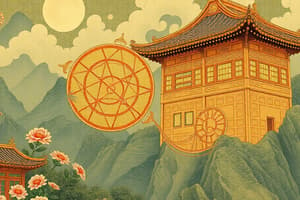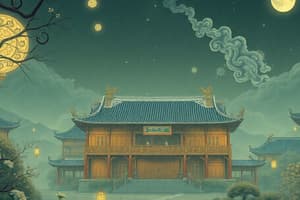Podcast
Questions and Answers
Which geographic feature lies to the west of China?
Which geographic feature lies to the west of China?
- The Yellow Sea
- The Gobi Desert
- The East China Sea
- The Himalayan Mountain Ranges (correct)
What core tenet underscored Shang culture?
What core tenet underscored Shang culture?
- Establishment of a large central government.
- Technological innovation in agriculture.
- Respect for family and ancestors. (correct)
- Territorial expansion through military conquest.
Which of the following best describes the method of divination used during the Shang dynasty?
Which of the following best describes the method of divination used during the Shang dynasty?
- Analyzing dreams and visions for prophetic insights.
- Scratching questions on oracle bones to communicate with Shangdi. (correct)
- Consulting with shamans who communicated with nature spirits.
- Interpreting celestial events through astrology.
How did the Zhou dynasty initially consolidate power after overthrowing the Shang?
How did the Zhou dynasty initially consolidate power after overthrowing the Shang?
Which period in Chinese history is characterized by intense conflict between regional lords?
Which period in Chinese history is characterized by intense conflict between regional lords?
How did advancements in metalworking technology impact Chinese society during the Bronze Age?
How did advancements in metalworking technology impact Chinese society during the Bronze Age?
Which of the following statements best reflects the Legalist philosophy as articulated by Han Fei?
Which of the following statements best reflects the Legalist philosophy as articulated by Han Fei?
According to Confucius, what is the foundation of a strong and stable society?
According to Confucius, what is the foundation of a strong and stable society?
Which of the following is a key aspect of Confucianism that promotes social harmony?
Which of the following is a key aspect of Confucianism that promotes social harmony?
What action by Confucius's students helped disseminate after his death?
What action by Confucius's students helped disseminate after his death?
Which of these actions by Shi Huangdi of the Qin dynasty directly contradicted the principles of Confucianism?
Which of these actions by Shi Huangdi of the Qin dynasty directly contradicted the principles of Confucianism?
Why was glutinous rice flour used in the construction of the Great Wall of China?
Why was glutinous rice flour used in the construction of the Great Wall of China?
What was the main philosophical difference between Legalism and Daoism during ancient China?
What was the main philosophical difference between Legalism and Daoism during ancient China?
How did the Han dynasty's approach to governance differ from that of the preceding Qin dynasty?
How did the Han dynasty's approach to governance differ from that of the preceding Qin dynasty?
What role did the Silk Road play in the cultural exchange between China and other regions?
What role did the Silk Road play in the cultural exchange between China and other regions?
How did the invention of paper during the Han dynasty impact Chinese society?
How did the invention of paper during the Han dynasty impact Chinese society?
What do the Terracotta Army figures suggest about the beliefs of the Qin Dynasty?
What do the Terracotta Army figures suggest about the beliefs of the Qin Dynasty?
How did the lifestyle in Han dynasty cities differ from that in rural farming communities?
How did the lifestyle in Han dynasty cities differ from that in rural farming communities?
Which of the technological advancements made in ancient China had the most significant impact on agriculture?
Which of the technological advancements made in ancient China had the most significant impact on agriculture?
What was the primary reason for the construction of the Great Wall of China?
What was the primary reason for the construction of the Great Wall of China?
Flashcards
Seas near China
Seas near China
Major bodies of water east of China.
Shang Dynasty
Shang Dynasty
A dynasty established by kings who controlled cities.
Shang Culture
Shang Culture
Respect for families and ancestors.
Zhou Dynasty
Zhou Dynasty
Signup and view all the flashcards
Han Fei
Han Fei
Signup and view all the flashcards
Legalism
Legalism
Signup and view all the flashcards
Confucius' View
Confucius' View
Signup and view all the flashcards
Taoism
Taoism
Signup and view all the flashcards
Confucius
Confucius
Signup and view all the flashcards
Confucian Relationships
Confucian Relationships
Signup and view all the flashcards
Confucianism
Confucianism
Signup and view all the flashcards
Qin Dynasty
Qin Dynasty
Signup and view all the flashcards
Shi Huangdi
Shi Huangdi
Signup and view all the flashcards
Great Wall of China
Great Wall of China
Signup and view all the flashcards
Silk
Silk
Signup and view all the flashcards
Silk Roads
Silk Roads
Signup and view all the flashcards
Buddhism
Buddhism
Signup and view all the flashcards
Study Notes
- Bodies of water surrounding China include the Yellow Sea, East China Sea, and the Pacific Ocean, all located east of China.
- The Gobi Desert and the Yellow River (Huang He River) are located north of China.
- The Taklimakan Desert, Himalayas, Pamir Mountains, and Tian Shan mountain ranges are west of China.
- The Chang Jiang River, or Yangtze River, is in central China.
- Farming communities evolved into cities around 2000 BCE.
- Shang kings controlled these cities and established a dynasty.
- Respect for families and ancestors were fundamental to Shang culture.
- Oracle bones were used to ask questions to Shangdi, a deity.
- Priests inscribed questions on animal bones or tortoise shells, representing an early form of writing.
Zhou Dynasty and Philosophies
- The Zhou dynasty overthrew the Shang Dynasty.
- The Zhou Dynasty is known for the philosophies of Taoism and Confucianism.
- Dynasties operate in a cycle.
- The Zhou dynasty lacked a strong central government.
- Zhou family members appointed lords, which led to infighting.
- This period of infighting is known as the "Time of the Warring States."
- Advanced technologies emerged during the Bronze Age, including the use of cast iron and bronze for tools and weapons.
- Han Fei, Confucius, and Lao-Tzu coined the philosophies legalism, confucianism, and taoism respectively.
- Confucius stated that the strength of the nation comes from the integrity of the home; strong family values are important.
- Taoism focuses on letting go of one's self to make room for growth.
- Legalism emphasizes the need for structure via rules of law to have a successful nation.
Confucianism and the Qin Dynasty
- China fell into chaos during the Zhou dynasty.
- Confucius, a teacher and government official, believed Chinese society was collapsing due to conflict.
- Confucianism outlines five key relationships: father and son, older and younger brother, husband and wife, ruler and subject.
- Confucius promoted education, family unity, and filial piety.
- Despite feeling like he failed, Confucius’ students compiled his teachings into a book called the Analects.
- Confucianism has influenced millions and has served as a unifying force in Chinese culture.
- The Qin dynasty unified China, strengthened imperial power, and implemented standardized systems.
- The dynasty built highways and irrigation projects.
- Weights, coins, writing, and measures were standardized.
- Shi Huangdi, a legalistic leader of the Qin dynasty, attempted to suppress Confucian teachings.
- The Great Wall of China was constructed along the northern border during the Qin dynasty.
- Most of the Great Wall is unrestored.
- Contrary to popular belief, the Great Wall is not visible from space.
- Glutinous rice flour was used to bind the bricks together to make the wall.
- The Great Wall was largely built by the Ming dynasty.
- The Great Wall is in a state of erosion.
- The Terracotta Warriors, created over 2000 years ago, are located near the tomb of the Qin dynasty's leader.
Belief Systems
- Ancient Chinese believed in the afterlife.
- Human sacrifices were common when lords and leaders died.
- The terracotta warriors were coated with a special mixture to prevent decay.
- Lao-Tzu founded Daoism.
- Daoism focuses on achieving harmony with nature, seeking balance in life.
- Legalism, led by Han Fei, emphasized order through law and a strong central government.
- The Qin dynasty embraced legalistic ideals.
Han Dynasty
- The Han dynasty defeated the Qin.
- Liu Bang was the leader of the Han Dynasty.
- The Han Dynasty promoted Confucianism.
- Empress Lu led the dynasty for a time.
- The Han dynasty ruled for 422 years.
- Emperor Wudi expanded the empire, almost to the size of modern China.
- Common people lived simple lives as farmers in mud houses.
- Han cities were bustling hubs of business, entertainment, and even street gangs.
Inventions and Trade
- Ancient China invented the plow, collar harness for horses, wheelbarrow, and watermill.
- Paper was invented in the year 105.
- Silk was highly valued.
- Cast iron production involved heating iron and pouring it into molds.
- The Silk Roads were trade routes connecting China to Europe.
- Chinese silk was in high demand during the Han dynasty.
- Cultural exchange occurred along with goods.
- Grapes, honey, spices, ivory, pottery, and rugs/blankets were traded
- Buddhism spread to China, Japan, and Korea.
Studying That Suits You
Use AI to generate personalized quizzes and flashcards to suit your learning preferences.




